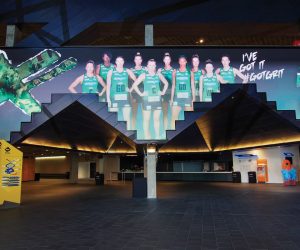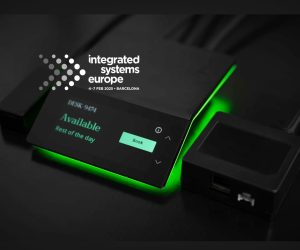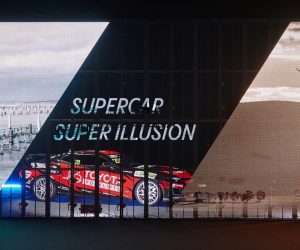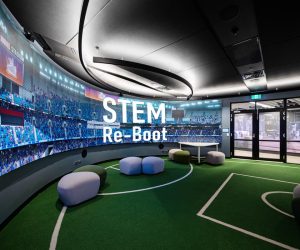
Quite The Entrance
Adelaide Entertainment Centre is ready for the next 30 years of entertainment.
Text:\ Graeme Hague
The Adelaide Entertainment Centre (AEC) opened in 1991 and faithfully served the Adelaide community to the point of reaching a record-breaking 378,000 patrons through its doors in 2008. At that time it was announced that a $52m facelift had been commissioned with the intention of taking the AEC at least another 30 years into the 21st century. The project went well, the workers hung up their hard hats on time in February 2010 and the AEC had itself a new 2500-seat theatre, while what was formerly known as the Alchemy function room was now a totally refitted Star Room.
An area outside the main entrance had been transformed with the completion of the ‘Orb’, a dome-shaped portico with a network of LEDs that created patterns and colours on the orb itself. Architectural lighting company Xenian were responsible for bringing to life design architect Ian Khoo’s concept of an ‘entry experience’ for visitors to the AEC. Adjacent to the orb a new electronic sign had been installed. At a whopping 67m-long and 2.4m-high it was at the time – and probably still is – the largest sign of its kind in the southern hemisphere.
Not surprisingly, the striking orb and its neighbouring, impressive sign caught our eye. However, when I started digging around for the background story an unexpected fact about the sign came to light. It had been supplied and installed by Harvey Norman Commercial.
GO HARVEY WHO?
Most people will associate the name Harvey Norman only with the giant whitegoods and electronics retailer. Learning of the existence of its Harvey Norman Commercial (HNC) division usually raises a few eyebrows, before it’s assumed that HNC is some kind of bulk-buy organisation for the trade to take advantage of Harvey Norman’s considerable buying power – and they’d be almost right. Harvey Norman Commercial has branches in all the states of Australia except Tasmania and in the words of Matt Vawser, franchisee of the South Australian HNC, these are “box moving entities”. While the idea is to offer the best expertise and customer service, HNC is still basically a sales outlet. The staff will stand at the door and cheerfully wave you goodbye as you drive away with a truck filled with goodies.
Except in Adelaide, where things are different. Matt Vawser is a qualified network engineer with an extensive background in installing integrated systems using C-Bus, Crestron and AMX equipment, to name but a few. He had a vision for HNC in South Australia to become a leading supplier of control networks and take the Harvey Norman Commercial business beyond just supplying pallet-loads of televisions. Matt decided to combine his engineering talents with the HNC brand and with the blessing of the Harvey Norman management was encouraged to give it a go.
He started off in the tough sector of servicing system networks in the pubs and clubs of Adelaide, and over several years earned a solid reputation. So it was no fluke that HNC Adelaide made a successful bid to supply and install over $4m worth of AV and digital signage as part of the Adelaide Entertainment Centre refit. To make the point that the AEC wasn’t a one-off project for them, HNC is currently finishing another significant project; the installation of AV screens at the Morphetville Race course involving a network of 11 x 103-inch plasma screens and some 460 smaller, Panasonic commercial plasma screens.
The large sign out the front was only a part of the deal – albeit around a $2m part. It’s made up of 126 x Ledavision P10 panels which were custom-built to 1600mm x 800mm each (normally they’re 1280mm x 960mm), and assembled in a grid of 42 panels long and three panels deep. From there, the panels were segregated into four sections. The entire sign has its own video processing and Crestron control system (as against the digital signage inside–more on that below) with a thermostat installed for each of the four parts.

SIGNING ON
Temperature control is a crucial element to the sign’s performance and maintenance and with Adelaide capable of weather extremes it was more than a simple fail-safe function. The physical installation of the modules required a custom flashing designed to improve air flow for cooling. The thermostat data is compared with the AEC’s building management system as a kind of double-check of the conditions. Temperature readings are also used to configure the brightness of the sign with an obvious correlation being made with heat equating to daytime and sunlight – although in Adelaide you never know.
The sign’s brightness caused the only real problem of the entire project. The Adelaide City Council soon requested that the output be dimmed down to around 20% at night, otherwise the nearby automatic streetlights would be confused and forget to switch on. Data to the signage is sent via a Crestron Digital Media 8 x 8 DVI matrix to four fibre optic send and receive processors providing 24-bit HD colour. In the main comms room, four 21-inch preview screens allow programmers to ensure that no unfortunate errors are displayed in all its 67m-wide splendour.
PLENTY TO LOOK AT
Inside the AEC the numbers don’t get any smaller. HNC provided 79 digital signage screens throughout the complex. The showpiece of the system is an array of 16 Samsung 46-inch UT displays, the UT model having the thinner bezels that create an almost seamless look. Otherwise most of the digital signage in the foyers and thoroughfares is displayed in banks of three Samsung UXN screens with each producing 1920×1080 pictures. The effect is achieved thanks to Matrox Quad Output cards in the main PC. Exceptions are 65-inch Panasonic plasmas installed in the kiosk area – let’s not have any misunderstandings about the beer prices. Data signals to the entire digital signage network is achieved with a Magenta Research infrastructure that uses UTP cabling terminating with one of Magenta’s own baluns at each screen. Again, a Crestron system is used to distribute the digital signal across the network.
CONTENT IS KING
Content for both the large screen and the internal digital signage is created in Adobe Flash or Photoshop, with Flash getting the nod most of the time. It’s then fed through a Navori Server digital signage system for distribution and scheduling across all the screens in the centre, including the huge LED array out front.
The existing audio system was also upgraded and expanded. A Neon Media matrix gave the AEC more concise control of exactly what’s broadcast where. Previously, the number of zones was limited and broadcasts could impact on areas that weren’t relevant to the material. With the Neon Matrix more zones and a tighter focus of the speaker system have fixed the problem. Frequent announcements have been recorded into the system including the original chimes to hasten the punters to their seats. Three mobile racks of audio equipment can be patched in around the centre and configured for the immediate area. Which brings us back to the Orb entry dome where a Renkus-Heinz Rhaon speaker system was installed.
WEAVING THE ORB
The curve of the dome is intended to mimic the existing arc of the AEC’s roof. The structure is made from a criss-cross of tubular steel that creates 140 squares. These squares are filled with panels made of a new architectural polymer – poly ethylene-co-tetrafluoroethylene that goes under the more pronounceable identity of ETFE. The surface needed to be lightweight and reflective and ETFE could provide this while lending itself to bending and twisting better than glass.
Two Philips Colour Kinetics LED fixtures illuminate each of the squares and it’s the reflection from the panels that creates the impression the ETFE panels are the light source. The LED technology and the pairing of fixtures allows the production of millions of different colours, while an array of 140 panels means that an enormous variety of patterns can be created. Patterns and programs for the Orb array are generated by Philips Colour Kinetics Light System Manager, an integrated hardware and software solution that incorporates Philip’s Light System Engine controller hardware and Light System Composer design software.
MAKING A SPLASH
The refurbishment of the Adelaide Entertainment Centre is an impressive, successful combination of the orb’s artistic and creative presence against a solid technical contribution from Matt Vawser’s team at Harvey Norman Commercial. It’s a great example of AV technology coming together to both work solidly in the background and be lighting up the streets at the same time.















RESPONSES